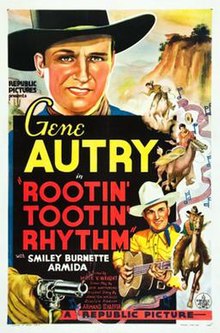|
Rootin' Tootin' Rhythm
Rootin' Tootin' Rhythm is a 1937 American Western film directed by Mack V. Wright and starring Gene Autry, Smiley Burnette, and Armida. Based on a story by Johnston McCulley, the film is about two cowboys who assume the identities of dead outlaws in order to stop a bunch of cattle rustlers, later discovering that the outlaws are far from dead.[2][3] PlotGene Autry (Gene Autry) and his sidekick Frog Millhouse (Smiley Burnette) decide to leave Gene's ranch in order to pursue cattle rustlers who have been terrorizing the range. The men they are following, the Apache Kid (Max Hoffman Jr.) and Black Jim (Charles King), kill two lawmen and exchange clothes with them. When Gene and Frog discover the bodies, they decide to take their clothes and, disguised as wanted outlaws, head for the border. Gene discovers that Joe Stafford (Monte Blue), a supposed upstanding head of the cattlemen's association, is the boss behind the rustling gang. When Stafford's niece, Rosa Montero (Armida), and his stepdaughter Mary Ellen (Ann Pendleton) mistake Gene and Frog for the Apache Kid and Black Jim, they turn them in to the deputies, who turn out to be the real outlaws in disguise. Gene and Frog are able to escape, and with the help of Gene's partner, Buffalo Bradey (Hal Taliaferro), and a group of singing cowhands, who eventually reveal themselves to be Texas Rangers, the rustlers are captured. After Stafford is killed, Gene and Frog return to Gene's ranch.[2] Cast
ProductionCastingMexican-born actress Armida was paid significantly more than Autry's past female co-stars, $750, for her appearance in Rootin' Tootin' Rhythm. According to Autry, she helped him to sing Spanish lyrics to film songs.[5] Filming and budgetRootin' Tootin' Rhythm was filmed March 10–20, 1937. The film had an operating budget of $23,500 (equal to $498,069 today), and a negative cost of $33,034.[2] Stuntwork
Filming locationsSoundtrack
Memorable quotes
References
External links |
||||||||||||||||||||||||||||||||||
Portal di Ensiklopedia Dunia
